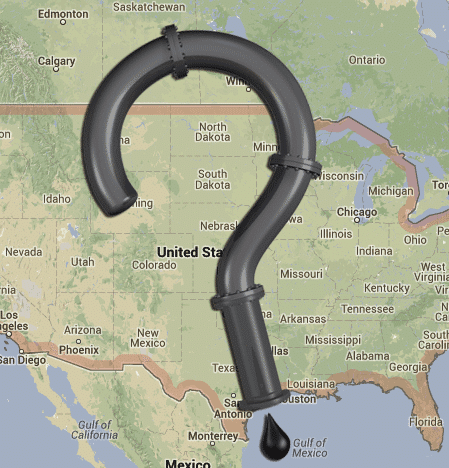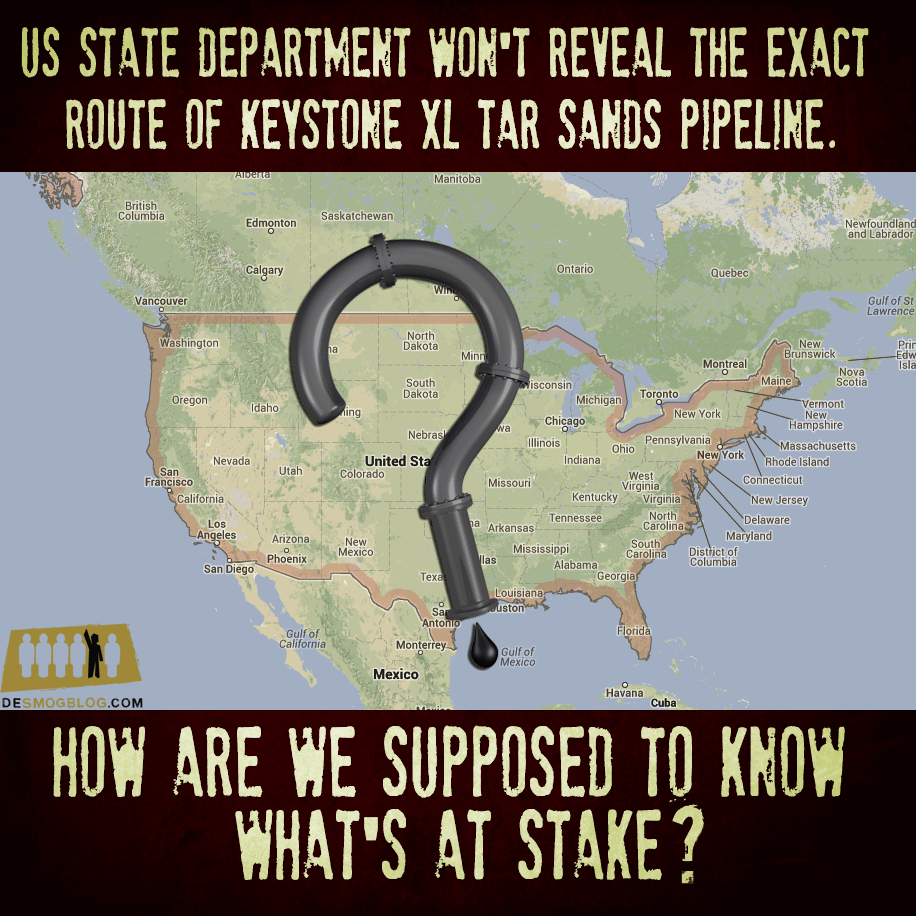Believe it or not, the precise route of TransCanada’s Keystone XL tar sands pipeline remains shrouded in mystery.
Of course, both TransCanada and the U.S. State Department have revealed basic Keystone XL route maps. And those who follow the issue closely know the pipeline would carry Alberta’s tar sands diluted bitumen or “dilbit” southward to Port Arthur, TX refineries and then be exported to the global market.
But the real path is still a secret: the actual route of KXL is still cloaked in secrecy. Case in point: the travails of Thomas Bachand, Founder and Director of the Keystone Mapping Project.
“I started out wanting to scout the route for a potential photography project. So I went looking for a map, and discovered there wasn’t one,” Bachand explained in a Nov. 2012 interview with National Public Radio. “I went over to the State Department website, and found some great information, but then I discovered there wasn’t any route information.”
His experience with TransCanada was even worse.
“TransCanada [also gave me] the runaround. Their excuse was that [releasing the information] was a national security risk, which is just a joke.”
Due to lack of transparency on the part of President Barack Obama’s State Department and TransCanada, what was once merely an ambitous photo-journalism project has morphed into a full-fledged muckraking effort – and a Freedom of Information Act (FOIA) request battle royale – that’s now lasted about a year and a half for Bachand. The State Department still has yet to give him the goods.
“I was initially told that 8-12 months was a typical turn around time for a FOIA,” Bachand explained to DeSmogBlog in an interview. “Keep in mind that many FOIA requests to the State Dept. require extensive searches through years of diplomatic cables. My request deals with a single project handled by a single department.”
Why the long delay on such a seemingly straight-forward request?
“I have been told that the main obstacle to my FOIA request with the Dept. of State for the…Keystone XL is that the information is ‘politically sensitive,’” Bachand explained of the situation in a June 26, 2012 blog post.
Missing the Forest for the Trees?
Bachand believes even the most ardent advocates fending off KXL are missing the forest for the trees on the State Dept. KXL Supplemental Environmental Impact Statement (SEIS).
The SEIS was penned by Environmental Resources Management (ERM Group), a dues-paying member of the American Petroleum Institute (API) which said KXL will have negligible climate change impacts, along with two other industry-tied contractors. API has spent $22 million lobbying on behalf of its members on KXL and tar sands since its initial June 2008 proposal, on top of the cash it has spent on its relentless public relations and advertising efforts.
“What’s been lost in the debate over the Keystone is that, as written, the EIS makes it impossible to determine the project’s environmental impacts,” Bachand told DeSmogBlog in an interview. “As all key features and landmarks are referenced to the nearest pipeline milepost marker, without milepost marker longitude and latitude data, one cannot make sense of the report.”
As of now, U.S. citizens aren’t even privy to information as basic as what water bodies the pipeline crosses, Bachand says. As seen in Mayflower, AR – when tens of thousands of gallons of tar sands crude from ExxonMobil’s Pegasus Pipeline spilled into Lake Conway from a pipeline few even knew existed until the latest “dilbit disaster” – knowledge is power and lack of it vice versa. Not knowing the exact route of the pipeline leaves impacted communities unable to anticipate threats to waterways where their local knowledge would be invaluable.
“Waterbody crossings are another key feature that is largely missing,” Bachand explained to DeSmog. “If the pipeline crossed a mile upstream from one’s property, or neighborhood, or community park, or aquifer, most people would want to know about it. Keep in mind that I am only looking at GIS data. One has to wonder what else is missing from the EIS.”
Bachand also believes that President Obama’s statement about deciding the fate of KXL exclusively on its climate change impact – at the expense of numerous significant ecological impacts – is foolhardy.
“Obama said that the KXL would only be approved if it did not contribute to climate change in his Climate Action Plan speech,” Bachand said. “Yet, one cannot determine global impacts without first giving due diligence to the immediate environmental impacts. Also, by focusing strictly on the impact of tar sands on the climate, pipeline opponents largely disassociate the debate from the pipeline’s ecological impacts.”
Next Steps for Bachand on Keystone Mapping Project
Although FOIA battles over basic KXL details were never the initial intention of Bachand’s project, he is now committed to work on the project for months, if not years to come.
“The project remains a work in progress. Of course I would like to see the mapping component completed, but as it is, it communicates the ‘incompleteness’ of both the Keystone concept and our policies on land and energy use,” he said in discussing his next steps. “If I can secure funding I would like to travel the pipeline route with the goal of producing a book and gallery exhibit.”
Bachand sees KXL as a climate change symbol – and as he’s learned, a symbol of broken democracy – with much significance beyond the immediate pipeline itself.
“KXL has become emblematic of our inability to reconcile world demand for fossil fuels and the environmental imperatives imposed upon modern civilization,” he said. “I’m glad TransCanada chose to name it the Keystone. It’s a perfect metaphor in so many ways.”
Subscribe to our newsletter
Stay up to date with DeSmog news and alerts







